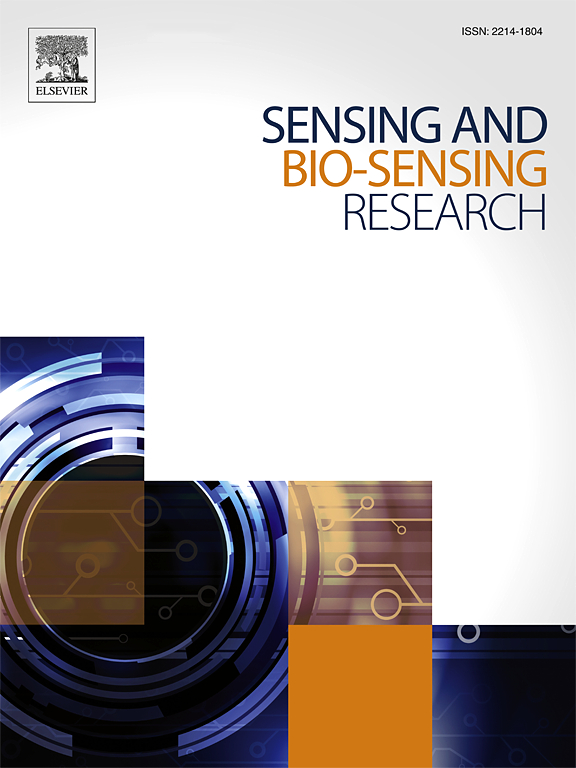Samarium oxide nanoparticle-modified gold electrodes for enhanced Voltammetric sensing of hydrazine and p-Nitrophenol
IF 5.4
Q1 CHEMISTRY, ANALYTICAL
引用次数: 0
Abstract
Samarium oxide (Sm2O3), such as electrochemical sensors, is a promising material in various application prospects and industries. Additionally, Sm2O3 leverages electron transport capabilities, high electrical conductivity, and thermal stability to develop an effective material in electrode modification for detecting hazardous pollutants. Hydrazine and p-nitrophenol are compounds commonly used in producing insecticides, pesticides, pharmaceuticals, and the chemical industry. However, these compounds can become hazardous environmental pollutants and pose serious health risks to humans. Therefore, this research aims to examine the impact of modifying gold electrode (GE) with Sm2O3 nanoparticles, characterizing the electrochemical results, and assessing sensor performance through the use of the GE/Sm2O3 NP electrode. In this context, the purpose is to detect hydrazine and p-nitrophenol through voltammetry, with analytical parameters including recovery, repeatability, detection limit, quantification limit, and linear range. The results show that the synthesis of Sm2O3 nanoparticles and the performance of the sensor and analytical parameters of GE/Sm2O3 NP are carried out in detecting hydrazine and p-nitrophenol using the Cyclic Voltammetry (CV) method. Furthermore, the significant increase in the current response validates the improvement of GE conductivity as an electron transporter. The sensor performance has been studied, and analytical parameters have been determined. For hydrazine and p-nitrophenol, the values are recovery of 98.74 % and 99.01 %, repeatability of 99.42 % and 98.45 %, limit of detection (LoD) of 0.4684 μM and 0.50332 μM, limit of quantification (LoQ) of 1.4194 μM and 1.5252 μM, and linear concentration range for both analytes from 0.1 μM to 7 μM.
纳米氧化钐修饰金电极对肼和对硝基苯酚的伏安感应
钐氧化物(Sm2O3)是一种具有广阔应用前景和行业前景的电化学传感器材料。此外,Sm2O3利用电子传输能力、高导电性和热稳定性,开发了一种有效的电极修饰材料,用于检测有害污染物。联氨和对硝基酚是通常用于生产杀虫剂、杀虫剂、药品和化学工业的化合物。然而,这些化合物会成为有害的环境污染物,对人类健康构成严重威胁。因此,本研究旨在研究用Sm2O3纳米颗粒修饰金电极(GE)的影响,表征电化学结果,并通过使用GE/Sm2O3 NP电极评估传感器性能。本文的目的是通过伏安法检测肼和对硝基苯酚,分析参数包括回收率、重复性、检出限、定量限和线性范围。结果表明,Sm2O3纳米颗粒的合成、GE/Sm2O3 NP传感器的性能和分析参数均可用于循环伏安法(CV)检测肼和对硝基苯酚。此外,电流响应的显著增加验证了GE作为电子传递体的电导率的改善。研究了传感器的性能,确定了传感器的分析参数。联氨和对硝基苯酚的回收率分别为98.74%和99.01%,重复性分别为99.42%和98.45%,检出限分别为0.4684 μM和0.50332 μM,定量限分别为1.4194 μM和1.5252 μM,浓度范围为0.1 μM ~ 7 μM。
本文章由计算机程序翻译,如有差异,请以英文原文为准。
求助全文
约1分钟内获得全文
求助全文
来源期刊

Sensing and Bio-Sensing Research
Engineering-Electrical and Electronic Engineering
CiteScore
10.70
自引率
3.80%
发文量
68
审稿时长
87 days
期刊介绍:
Sensing and Bio-Sensing Research is an open access journal dedicated to the research, design, development, and application of bio-sensing and sensing technologies. The editors will accept research papers, reviews, field trials, and validation studies that are of significant relevance. These submissions should describe new concepts, enhance understanding of the field, or offer insights into the practical application, manufacturing, and commercialization of bio-sensing and sensing technologies.
The journal covers a wide range of topics, including sensing principles and mechanisms, new materials development for transducers and recognition components, fabrication technology, and various types of sensors such as optical, electrochemical, mass-sensitive, gas, biosensors, and more. It also includes environmental, process control, and biomedical applications, signal processing, chemometrics, optoelectronic, mechanical, thermal, and magnetic sensors, as well as interface electronics. Additionally, it covers sensor systems and applications, µTAS (Micro Total Analysis Systems), development of solid-state devices for transducing physical signals, and analytical devices incorporating biological materials.
 求助内容:
求助内容: 应助结果提醒方式:
应助结果提醒方式:


